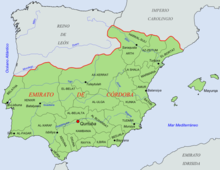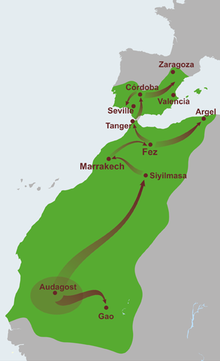Eastern islands of al-Andalus
Under Muslim rule (903 to 1229, on Menorca to 1287) , the Balearic Islands were referred to as the Eastern Islands of al-Andalus . They included Mayūrqa ( Mallorca ), Manūrqa ( Menorca ), Yabissa ( Ibiza ) and Faramantira ( Formentera ). Its political organization changed considerably over the course of three centuries of Islamic rule - starting from a clear dependence on central power during the Caliphate of Córdoba, through intermediary states, to complete independence during the Taifa of Mallorca .
prehistory
From 534 the Balearic Islands were integrated into the Byzantine Empire as part of the province of Sardinia . In 705 Mūsā ibn Nusair had finally conquered the north-west African possessions from Byzantium. In 707 he sent his son Abd Allah ibn Mūsā ibn Nusair on a campaign against Sicily , Sardinia and the Balearic Islands. With each of the governors there, Abd Allah signed a contract for their submission (in Arabic ahd ). He even brought the Byzantine governors of Mallorca and Menorca to Damascus to negotiate directly with the Umayyad caliph al-Walid ibn Abd-al-Malik .
However, it is unclear to what extent these treaties were effective. Other Muslim raids organized from Tortosa in 797 , embassies from the islanders to the court of Charlemagne in 798 , and Carolingian aid expeditions in the same year and in 813 suggest that between the end of the 8th and At the beginning of the 9th century the complete subjugation of the Balearic Islands to Muslim rule was not yet complete.
In 848 the Emir of Córdoba Abd ar-Rahman II forced the Balearic Islands to pay taxes. The following year the islands sent a delegation to the court of Abd ar-Rahmans to have their old status restored.
The Islamic Conquest of Mayūrqa
The actual conquest of Mallorca by Muslim troops took place between 902 and 903. The Saracen expedition was commanded by Issam al-Khawlani . Despite eight years of resistance by Christians at Castell d'Alaró , the islands were finally incorporated into the emirate of Córdoba as Cora under the name al-jaza'ir al-sharquiya li-l-andalus (the eastern islands of al-Andalus ). Issam al-Khawlani was installed as Wālī and thus the process of Islamization of the Balearic Islands began. The old Roman city of Palma became the capital of the Cora with the name Madinat Mayūrqa . At the same time Mallorca was divided into 12 so-called Juz : Bulānsa, Inkān, al-Djibāl, Murūh, Šulyar, Yartān, Manaqūr, Muntūy, Qanarūša, Bunyūla-Mūsū, Djijnaw-Bitrah, Ahwāz al Madīna and the 13th (unsure) al- Buhayra. Yabisah (Ibiza) was divided into 5 juz : Burtumān, Benīzamid, Šarq, Algarb and Alhaueth. Finally, Minūrqa consisted of 4 juz : Benīfabim, Hasmalujda, Alscaions and Benīssaida.
Mayūrqa under the Caliphate of Cordoba
Only a few years later (around 929) the Umayyad emir cut Abd ar-Rahman III. all connections with the Abbasid caliph in Baghdad and proclaimed himself Umayyad caliph in Cordoba. Under the Caliphate, the Mallorcans participated in several raids on the Occitan and Catalan coasts. Internal tensions, however, led to the collapse of the caliphate, which was officially declared over in 1031. In its place, various smaller kingdoms - the taifas - were formed .
Wālīs under the emirate or caliphate of Córdoba
- Issam al-Khawlani (902 to 913)
- Abd-Allah ibn Issam al-Khawlani (913 to 946)
- al-Muwaffaq (946 to 969)
- Kawtar (969 to 998)
- Muqatil ( 998-1012 ).
Mayūrqa during the Dénia typhoon
In 1015 the Balearic Islands were conquered by Abu-l-Jais ibn Yusuf al-Muwaffaq , known as Mujahid , and incorporated into his possessions in the Taifa of Dénia . Abu-l-Jais turned Mayūrqa into a naval base from which attacks and looting were carried out on Christian coastal neighbors. He was followed by his son Ali ibn Mujahid Iqbal al-Dawla , who had to submit to the Taifa of Saragossa Ahmad I al-Muqtadir from the Yemeni dynasty of the Banu Hūd in 1067 when he and his army appeared in front of Dāniyya (Dénia). The Taifa of Saragossa had thus acquired the islands without a fight. Nevertheless, the Wālī of Mayūrqa Abd Allah al-Murtada ibn Aglab acted totally independently and even declared himself a Taifa and Emir in 1087.
Wālīs of Mayūrqa under the Emirate of Dénia
- Abu-l-Abbas ibn Raschiq (1016 to 1048)
- al Aglab (around 1048)
- Sulayman ibn Maschiqan (until 1076)
- Abd Allah al-Murtada ibn Aglab (1076 to 1087).
First Mayūrqa Taifa and Pisan-Catalan crusade
Under Abd Allah al-Murtada ibn Aglab, the Taifa of Mayūrqa had developed into an outspoken pirate center of the western Mediterranean. The Republic of Pisa was therefore determined to end the Mallorcan pirate mischief and organized with the support of the Catalan troops Raimund Berengars III. a crusade against the Taifa of Mayūrqa. In the course of this enterprise Eivissa (Ibiza) was conquered in 1114 and Madīna Mayūrqa looted and destroyed. The crusade troops withdrew from the island archipelago in 1115 as soon as they were informed of the approach of the Almoravid army on the peninsula, but were still able to free the Christian prisoners. Similar to the rest of al-Andalus, the Mozarabic- speaking population on Mallorca fled almost completely from the Almoravids.
Independent emirs in Mallorca (1087 to 1115)
- Abd Allah al-Murtada ibn Aglab (1087-1093), independent Emir of Mayurqa
- Mubashir Nassir-al-Dawla (1093 to 1114)
- Abu Rabi Sulaiman (1114 to 1115).
Mayūrqa among the Almoravids
After Toledo fell into the hands of Alfonso VI in 1085 . had fallen from Castile, the small Andalusian Taifa kingdoms called on the integristic sect of the Almoravids, which was mainly composed of Amazigh Berbers. They landed on the south coast of Iberia, defeating Alfonso VI in 1086 in the battle of Zallaqa . and prepared to conquer, step by step, all the Taifa kingdoms in al-Andalus and incorporate them into their empire. In 1115, shortly after the crusade troops withdrew from Mallorca, the Almoravids also conquered the Balearic Islands and made them part of their empire.
Second Taifa of Mayūrqa among the Ghaniyids
In the south of Morocco , however, a new, even more rigorous sect had emerged with the Almohads , which gradually gained hegemony in North Africa and ultimately also conquered al-Andalus, leaving Mayūrqa as the last bastion of the Almoravids. Since then, the Balearic Islands have been ruled by the independent Almoravid dynasty of the Banu Ghaniya , whose rulers declared themselves to be emirs in the second Taifa of Mayūrqa. Their reign is again marked by piracy against Christian sea powers, although they had signed treaties with the Italian republics (Pisa, Genoa and Lucca).
Almoravid Wālīs and emirs of the Ghaniyids in Mallorca (1116 to 1203)
- Wanur ibn Abi Bakr (1116 to 1126)
- Muhammad ibn Ali ibn Ghaniya (1126 to 1155)
- Ishaq ibn Muhammad ibn Ghaniya (1155 to 1184)
- Muhammad ibn Ishaq ibn Ghaniya (1184)
- Ali ibn Ishaq ibn Ghaniya (1184 to 1185)
- Muhammad ibn Ishaq ibn Ghaniya (1185 to 1187), second term
- Tashfin ibn Ishaq ibn Ghaniya (1187)
- Abd Allah ibn Ishaq ibn Ghaniya (1187 to 1203).
Mayūrqa among the Almohads
In 1203 the Almohads set out to conquer the Mayurqa ruled by Abd Allah ibn Ishaq ibn Ghaniya in order to undermine the Almoravid resistance in Ifrīqiya . From this point on, the Balearic Islands were fully integrated into the Almohad Caliphate and were ruled by various Wālīs who had been installed from Marrakech , the capital of the Almohad Empire. The first Almohad Wālī in Mayūrqa in 1203 was Abd Allah ibn Ta'Allah al-Kumi .
The Almohad civil war and the de facto independence of Mayūrqa
The disastrous defeat of the Almohads at the Battle of Las Navas de Tolosa in 1212, inflicted on them by the united Christian kings, created an internal crisis in the caliphate that profoundly challenged their integrist regime. In a relatively short time, eight caliphs followed one another, new ruling dynasties emerged in the Maghreb and the third taifas appeared in Iberia. In this politically confused situation, the last Wālī of Mayūrqa Abu Yahya Muhammad ibn Ali ibn Abi Imran al-Tinmalali could act almost independently of the Almohad caliph Idris I al-Ma'mun .
Wālīs of the Almohads in Mallorca (1203 to 1229)
- Abd Allah ibn Ta'Allah al-Kumi (1203)
- Abu Zayd ibn Tujan (1204 to 1208)
- Abu Abd-Allah ibn Abi Hafs ibn Abdelmumen (1208)
- Abu Yahya Muhammad ibn Ali ibn Abi Imran al-Tinmalali (1208 to 1229), practically independent.
The Catalan Conquest of the Balearic Islands
On December 23, 1228, the Corts in Barcelona granted James I's request to conquer the Balearic Islands and undertook to ensure the supply of troops, weapons, ships, horses, food and other necessities. On September 5th of the following year 1229 the Catalan naval association cast off from Salou , Cambrils and Tarragona and landed on September 11th in Santa Ponça on Mallorca. On December 31, 1229 Madina Mayurqa fell after three months of resistance. In the Sierra de Tramuntana and in the Serres de Llevant there were other pockets of resistance, but they were finally smothered in 1232.
In the year 1231, James I managed by a ruse to force the leader of the Almohads on Menorca to pay tribute, which was agreed in writing in the Treaty of Capdepera (James I had kindled huge fires at Capdepera to intimidate the Menorcans in Capdepera were clearly visible in order to simulate the presence of a huge army).
Ibiza and Formentera were conquered on August 8, 1235 after a feudal treaty between James I and Guillermo de Montgrí , Bernardo de Santa Eugenia , Peter of Portugal and Nuno Sanchez of Roussillon , which the Pityuses then took possession of.
Last Islamic bastion: Manūrqa
Manūrqa was thus the last Islamic bastion in the Balearic Islands. Initially, the old, inherited rulership structures from the Almohad period still existed. In 1234, however, Abu Uthman Said ibn Hakam al-Quraschi seized power by force and restructured the administration of the island at his discretion. He installed a military bureaucratic system, had his own coins minted and drew very important Muslim intellectuals to his court. After his death in 1282 he was followed by his son Abu Umar ibn Said . In 1287 Menorca finally fell into the hands of Alfonso III. .
Qādī or Raʾīs in Manūrqa (1229 to 1287)
- Abu Abd Allah Muhammad ibn Ahmad ibn Hischam (1229 to 1234), Qādī
- Abu Uthman Said ibn Hakam al-Quraschi (1234 to 1282), Raʾīs
- Abu Umar ibn Said (1282 to 1287), Raʾīs.







